#US Patent and Trademark Office
Text
Goods and Services and Canna Trademarks
By Fred Rocafort, Attorney at Harris Sliwoski
Goods and services (G&S) identifications are a critical part of a cannabis trademark application, as with any other trademark application. An improper identification can delay an application, and in the worst cases prove fatal. Cannabis brands in particular have to be very careful when it comes to G&S.
Trademark rights are linked to specific goods and…
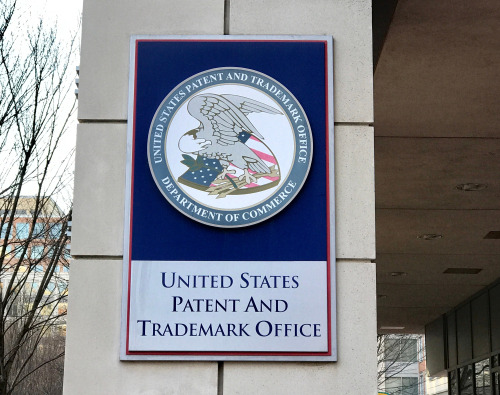
View On WordPress
#Controlled Substances Act (CSA)#Drug#Federal Food#Federal Food Drug and Cosmetic Act (“FDCA”)#The US Patent and Trademark Office’s (“USPTO”)#trademarks#USPTO
0 notes
Text
Legal Standing in Trademark Non-Use Cancellation Actions
Legal Standing in Trademark Non-Use Cancellation Actions
In recent years the Mexican Patent and Trademark Office (IMPI) allowed the possibility that complainants credit their legal standing on trademark non-use cancellation proceedings through the existence of a trademark application without the need of initially demonstrating that such application was blocked to registration in view of the prior existence of third parties’ confusingly similar…

View On WordPress
#business#IMPI#Intellectual property#IP Law#legal#Mexican Patent and Trademark Office#Mexico#non use cancellation actions#trademarks
1 note
·
View note
Text
An adversarial iMessage client for Android
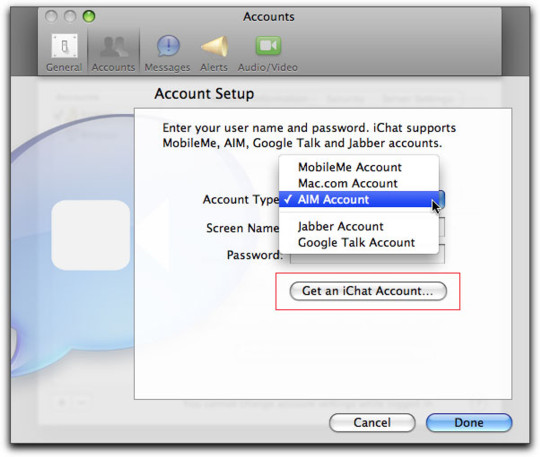
Adversarial interoperability is one of the most reliable ways to protect tech users from predatory corporations: that's when a technologist reverse-engineers an existing product to reconfigure or mod it (interoperability) in ways its users like, but which its manufacturer objects to (adversarial):
https://www.eff.org/deeplinks/2019/10/adversarial-interoperability
"Adversarial interop" is a mouthful, so at EFF, we coined the term "competitive compatibility," or comcom, which is a lot easier to say and to spell.
Scratch any tech success and you'll find a comcom story. After all, when a company turns its screws on its users, it's good business to offer an aftermarket mod that loosens them again. HP's $10,000/gallon inkjet ink is like a bat-signal for third-party ink companies. When Mercedes announces that it's going to sell you access to your car's accelerator pedal as a subscription service, that's like an engraved invitation to clever independent mechanics who'll charge you a single fee to permanently unlock that "feature":
https://www.techdirt.com/2023/12/05/carmakers-push-forward-with-plans-to-make-basic-features-subscription-services-despite-widespread-backlash/
Comcom saved giant tech companies like Apple. Microsoft tried to kill the Mac by rolling out a truly cursèd version of MS Office for MacOS. Mac users (5% of the market) who tried to send Word, Excel or Powerpoint files to Windows users (95% of the market) were stymied: their files wouldn't open, or they'd go corrupt. Tech managers like me started throwing the graphic designer's Mac and replacing it with a Windows box with a big graphics card and Windows versions of Adobe's tools.
Comcom saved Apple's bacon. Apple reverse-engineered MS's flagship software suite and made a comcom version, iWork, whose Pages, Numbers and Keynote could flawlessly read and write MS's Word, Excel and Powerpoint files:
https://www.eff.org/deeplinks/2019/06/adversarial-interoperability-reviving-elegant-weapon-more-civilized-age-slay
It's tempting to think of iWork as benefiting Apple users, and certainly the people who installed and used it benefited from it. But Windows users also benefited from iWork. The existence of iWork meant that Windows users could seamlessly collaborate on and share files with their Mac colleagues. IWork didn't just add a new feature to the Mac ("read and write files that originated with Windows users") – it also added a feature to Windows: "collaborate with Mac users."
Every pirate wants to be an admiral. Though comcom rescued Apple from a monopolist's sneaky attempt to drive it out of business, Apple – now a three trillion dollar company – has repeatedly attacked comcom when it was applied to Apple's products. When Apple did comcom, that was progress. When someone does comcom to Apple, that's piracy.
Apple has many tools at its disposal that Microsoft lacked in the early 2000s. Radical new interpretations of existing copyright, contract, patent and trademark law allows Apple – and other tech giants – to threaten rivals who engage in comcom with both criminal and civil penalties. That's right, you can go to prison for comcom these days. No wonder Jay Freeman calls this "felony contempt of business model":
https://pluralistic.net/2023/11/09/lead-me-not-into-temptation/#chamberlain
Take iMessage, Apple's end-to-end encrypted (E2EE) instant messaging tool. Apple customers can use iMessage to send each other private messages that can't be read or altered by third parties – not cops, not crooks, not even Apple. That's important, because when private messaging systems get hacked, bad things happen:
https://en.wikipedia.org/wiki/2014_celebrity_nude_photo_leak
But Apple has steadfastly refused to offer an iMessage app for non-Apple systems. If you're an Apple customer holding a sensitive discussion with an Android user, Apple refuses to offer you a tool to maintain your privacy. Those messages are sent "in the clear," over the 38-year-old SMS protocol, which is trivial to spy on and disrupt.
Apple sacrifices its users' security and integrity in the hopes that they will put pressure on their friends to move into Apple's walled garden. As CEO Tim Cook told a reporter: if you want to have secure communications with your mother, buy her an iPhone:
https://finance.yahoo.com/news/tim-cook-says-buy-mom-210347694.html
Last September, a 16-year old high school student calling himself JJTech published a technical teardown of iMessage, showing how any device could send and receive encrypted messages with iMessage users, even without an Apple ID:
https://jjtech.dev/reverse-engineering/imessage-explained/
JJTech even published code to do this, in an open source library called Pypush:
https://github.com/JJTech0130/pypush
In the weeks since, Beeper has been working to productize JJTech's code, and this week, they announced Beeper Mini, an Android-based iMessage client that is end-to-end encrypted:
https://beeper.notion.site/How-Beeper-Mini-Works-966cb11019f8444f90baa314d2f43a54
Beeper is known for a multiprotocol chat client built on Matrix, allowing you to manage several kinds of chat from a single app. These multiprotocol chats have been around forever. Indeed, iMessage started out as one – when it was called "iChat," it supported Google Talk and Jabber, another multiprotocol tool. Other tools like Pidgin have kept the flame alive for decades, and have millions of devoted users:
https://www.eff.org/deeplinks/2021/07/tower-babel-how-public-interest-internet-trying-save-messaging-and-banish-big
But iMessage support has remained elusive. Last month, Nothing launched Sunchoice, a disastrous attempt to bring iMessage to Android, which used Macs in a data-center to intercept and forward messages to Android users, breaking E2EE and introducing massive surveillance risks:
https://www.theverge.com/2023/11/21/23970740/sunbird-imessage-app-shut-down-privacy-nothing-chats-phone-2
Beeper Mini does not have these defects. The system encrypts and decrypts messages on the Android device itself, and directly communicates with Apple's servers. It gathers some telemetry for debugging, and this can be turned off in preferences. It sends a single SMS to Apple's servers during setup, which changes your device's bubble from green to blue, so that Apple users now correctly see your device as a secure endpoint for iMessage communications.
Beeper Mini is now available in Google Play:
https://play.google.com/store/apps/details?id=com.beeper.ima&hl=en_US
Now, this is a high-stakes business. Apple has a long history of threatening companies like Beeper over conduct like this. And Google has a long history deferring to those threats – as it did with OG App, a superior third-party Instagram app that it summarily yanked after Meta complained:
https://pluralistic.net/2023/02/05/battery-vampire/#drained
But while iMessage for Android is good for Android users, it's also very good for Apple customers, who can now get the privacy and security guarantees of iMessage for all their contacts, not just the ones who bought the same kind of phone as they did. The stakes for communications breaches have never been higher, and antitrust scrutiny on Big Tech companies has never been so intense.
Apple recently announced that it would add RCS support to iOS devices (RCS is a secure successor to SMS):
https://9to5mac.com/2023/11/16/apple-rcs-coming-to-iphone/
Early word from developers suggests that this support will have all kinds of boobytraps. That's par for the course with Apple, who love to announce splashy reversals of their worst policies – like their opposition to right to repair – while finding sneaky ways to go on abusing its customers:
https://pluralistic.net/2023/09/22/vin-locking/#thought-differently
The ball is in Apple's court, and, to a lesser extent, in Google's. As part of the mobile duopoly, Google has joined with Apple in facilitating the removal of comcom tools from its app store. But Google has also spent millions on an ad campaign shaming Apple for exposing its users to privacy risks when talking to Android users:
https://www.theverge.com/2023/9/21/23883609/google-rcs-message-apple-iphone-ipager-ad
While we all wait for the other shoe to drop, Android users can get set up on Beeper Mini, and technologists can kick the tires on its code libraries and privacy guarantees.

If you'd like an essay-formatted version of this post to read or share, here's a link to it on pluralistic.net, my surveillance-free, ad-free, tracker-free blog:
https://pluralistic.net/2023/12/07/blue-bubbles-for-all/#never-underestimate-the-determination-of-a-kid-who-is-time-rich-and-cash-poor
#pluralistic#multiprotocol#interoperability#adversarial interop#beeper#reverse engineering#blue bubbles#green bubbles#e2ee#end to end encrypted#messaging#jjtech#pypushbeeper mini#matrix#competitive compatibility#comcom
1K notes
·
View notes
Text
"The majority of high-tech patent lawsuits are brought by patent trolls—companies that exist not to provide products or services, but primarily have a business using patents to threaten others’ work. Some politicians are proposing to make that bad situation worse. ...
The Patent Eligibility Restoration Act, S. 2140, (PERA), sponsored by Senators Thom Tillis (R-NC) and Chris Coons (D-DE) would be a huge gift to patent trolls, a few tech firms that aggressively license patents, and patent lawyers. For everyone else, it will be a huge loss. That’s why we’re opposing it, and asking our supporters to speak out as well.
Patent trolling is still a huge, multi-billion dollar problem that’s especially painful for small businesses and everyday internet users. But, in the last decade, we’ve made modest progress placing limits on patent trolling. The Supreme Court’s 2014 decision in Alice v. CLS Bank barred patents that were nothing more than abstract ideas with computer jargon added in. Using the Alice test, federal courts have kicked out a rogue’s gallery of hundreds of the worst patents.
Under Alice’s clear rules, courts threw out ridiculous patents on “matchmaking”, online picture menus, scavenger hunts, and online photo contests. The nation’s top patent court, the Federal Circuit, actually approved a patent on watching an ad online twice before the Alice rules finally made it clear that patents like that cannot be allowed. The patents on “bingo on a computer?” Gone under Alice. Patents on loyalty programs (on a computer)? Gone. Patents on upselling (with a computer)? All gone. ...
PERA’s attempt to roll back progress goes beyond computer technology. For almost 30 years, some biotech and pharmaceutical companies actually applied for, and were granted, patents on naturally occuring human genes. As a consequence, companies were able to monopolize diagnostic tests that relied on naturally occurring genes in order to help predict diseases such as breast cancer, making such testing far more expensive. The ACLU teamed up with doctors to confront this horrific practice, and sued. That lawsuit led to a historic victory in 2013 when the Supreme Court disallowed patents on human genes found in nature.
If PERA passes, it will explicitly overturn that ruling, allowing human genes to be patented once again. ...
“To See Your Own Blood, Your Own Genes”
From the 1980s until the 2013 Myriad decision, the U.S. Patent and Trademark Office granted patents on human genomic sequences. If researchers “isolated” the gene—a necessary part of analysis—they would then get a patent that described isolating, or purified, as a human process, and insist they weren’t getting a patent on the natural world itself.
But this concept of patenting an “isolated” gene was simply a word game, and a distinction without a difference. With the genetic patent in hand, the patent-holder could demand royalty payments from any kind of test or treatment involving that gene. And that’s exactly what Myriad Genetic did when they patented the BRCA1 and BRCA2 gene sequences, which are important indicators for the prevalence of breast or ovarian cancer.
Myriad’s patents significantly increased the cost of those tests to U.S. patients. The company even sent some doctors cease and desist letters, saying the doctors could not perform simple tests on their own patients—even looking at the gene sequences without Myriad’s permission would constitute patent infringement.
This behavior caused pathologists, scientists, and patients to band together with ACLU lawyers and challenge Myriad’s patents. They litigated all the way to the Supreme Court, and won. “A naturally occurring DNA segment is a product of nature and not patent eligible merely because it has been isolated,” the Supreme Court stated in Association for Molecular Pathology v. Myriad Genetics.
A practice like granting and enforcing patents on human genes should truly be left in the dustbin of history. It’s shocking that pro-patent lobbyists have convinced these Senators to introduce legislation seeking to reinstate such patents. Last month, the President of the College of American Pathologists published an op-ed reminding lawmakers and the public about the danger of patenting the human genome, calling gene patents “dangerous to the public welfare.”
As Lisbeth Ceriani, a breast cancer survivor and a plaintiff in the Myriad case said, “It’s a basic human right to see your own blood, your own genes.” "
147 notes
·
View notes
Text
Lallybroch: copyright vs. trademark
An excellent question was asked by our friend @rosfrank in the comments thread to 'The door faces North' post and given the cosmic amount of uninformed bullshit being ventilated for almost ten years in this fandom, I think it's time to answer it once and for all:
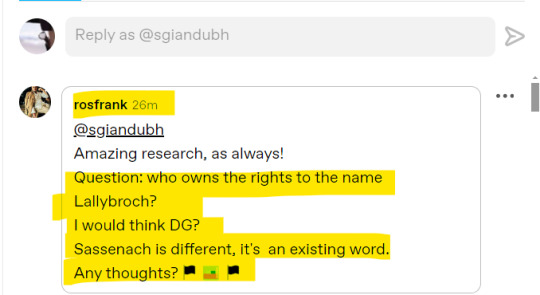
Whenever we are informally talking about 'owning the rights to something', I think it's very important to bear in mind a fundamental distinction between two different categories of ownership rights: copyright and trademark.
The copyright is the most familiar one to many of you. It is what you usually find on those annoying and apparently useless first or last pages of all the printed or digital editions on this planet. Something like this:

In the US, copyright issues are regulated by the Copyright Act of 1976, as included in Title 17 of the US Code. The US public authority competent for registering and managing copyright is, as predictable, the US Copyright Office.
Perhaps the most seminal US Supreme Court decision, as far as copyright is concerned, is the 1991 Feist Publications, Inc., v. Rural Telephone Service Co. In it, the Court ruled that mere compilations of information or facts (such as, for example, telephone books) are not protected by copyright, according to US law. In other words, the ancient legal concept of 'sweat of the brow' (which simply means the amount of work required to gather and compile those facts/information) is not enough to qualify a work for copyright protection, if no creative effort is added to enhance its content. This is why I have always considered absolutely ridiculous Marple's efforts to watermark public information screenshots: it is useless (to the extent that it legally protects her from nothing) and, as her timelines, a mere compilation of facts (legally ditto). A similar approach is preferred by the UK and also by many Roman law legal systems, such as the French one - just making things clearer, here, by the way.
See how 'Erself is roughly doing, right now, in this department:
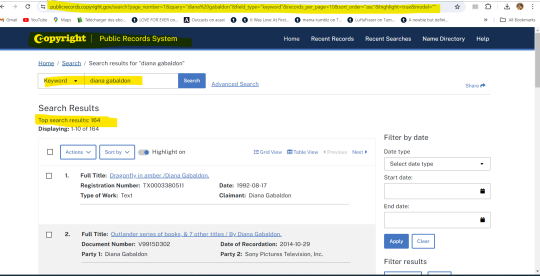
But I am rambling. In my view, Lallybroch, as a pivotal concept used in Diana Gabaldon's books, is protected by the copyright granted to each and every of her books mentioning it, according to the Roman law principle 'accessorium sequitur principale' (the accessory follows the principal). So it will remain protected for at least 70 years since the last of her books mentioning it would have been published under copyright. Unless she chooses to separately protect the entire finished cycle as a whole, once Book Ten (fingers crossed) is published, preferably during our foreseeable lifetimes.
That being said, that goes only for one copyright category: (published) text - you cannot copyright that secret diary in your drawer, LOL. This is why, the current US Copyright Office records concerning Lallybroch look like this:

Sony Pictures Television Inc owns the copyright to the fictional name Lallybroch in the motion pictures category, as it is the title of the Episode 12, in Season 1 - DG has been handsomely compensated for this, no worries. And someone I have no idea about owns the rights to an original musical score she has written and titled Lallybroch in the music category, since October 2013.
Onwards to the trademark. This is something different and this is all about making your name/concept/idea profitable. It is all about branding it, putting it on a product and selling it under that brand. It includes all the graphic elements and the logo of the brand (accessorium...) - in short, its visual identity to the consumers. In the US, trademark issues are regulated by the 1946 Lanham Act and the public competent authority is the good old US Patent and Trade Office (USPTO).
Right now, the situation for the Lallybroch trademark is as follows:
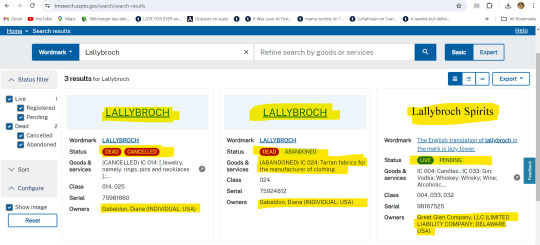
So, we see three different trademarks: two of them, owned by Diana Gabaldon, are classified as 'dead' (cancelled and/or abandoned) and the third, Lallybroch Spirits, owned by S's Great Glen Company is pending approval - he will not be able to label any booze bottle Lallybroch Drink Me before permission is granted by the USPTO.
Let's unpack:
Both Lallybroch trademarks formerly owned by Diana Gabaldon were filed at the USPTO on February 21, 2000 and granted on December 12, 2000. The first was aimed at producing 'tartan fabrics for the manufacturer of clothing' and it was abandoned in December 2003:

The reason is that the owner did not file in any Statement of Use after the trademark was granted. She had three years to do so, and since she chose not to do anything about it, the trademark was deemed abandoned (Stacy K. Smith is the attorney hired by Herself, btw). That means she specifically implied not to intend using it in the future. As such, she may claim NO rights on a now free to use mark:

The second trademark was aimed at producing 'clothing, namely, t-shirts, dresses and headwear' and also 'jewelry, namely, rings, pins and necklaces'- to cut the story short: OL merchandise - and it was cancelled on March 1st, 2013:
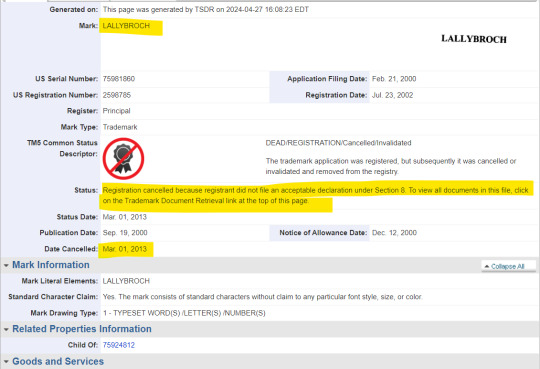
The reason is that the owner did not file the Section 8 declaration (of continuous use for five years) within the allowed legal timeframe (6 months after the fifth anniversary of the trademark granting renewal). Her trademark federal rights are now deemed canceled (but not her state law and/or common law rights!) and if she wants to ever use that name again, she would have to start the whole process over, bearing in mind the trademark could have been granted to someone else, in the meanwhile (not her case).
And for anyone who might ask, 'Erself does not own any other trademarks whatsoever:

The other (Doll Lab - LOL for ages) Diana Gabaldon is a pharmacist from Albuquerque, NM. Chill. 🤣🤣🤣
The owner of the copyright to the fictional toponym Lallybroch, as far as published text is concerned, is Diana Galabdon.
The owner of the copyright to the fictional toponym Lallybroch, as far as motion pictures are concerned, is Sony Pictures Television Inc.
The owner of the copyright to the fictional toponym Lallybroch, as a personal work of music, is Mrs. Kelly Ruth Davis, of Pennsylvania, USA.
The owner of the Lallybroch Spirits trademark will be Sam Roland Heughan, when that trademark is granted by the USPTO.
I hope this answers your question, @rosfrank. Thank you for asking.
112 notes
·
View notes
Text
Context-Full Patent Art
Every now and then I see people in the comments who seem to genuinely want a better idea of what one of the posted bits of art here was supposed to be patenting. Giving that context myself doesn't seem in the spirit of the blog, but I absolutely want to encourage people to do the legwork to go sniffing around for original sources.
It's something I have to do a lot in my day job, something I've learned to enjoy, and the thing that led me to start Context-Free Patent Art a dozen years ago in the first place.
Let's start with today's post, which is a perfect example of art that raises more questions than it answers.
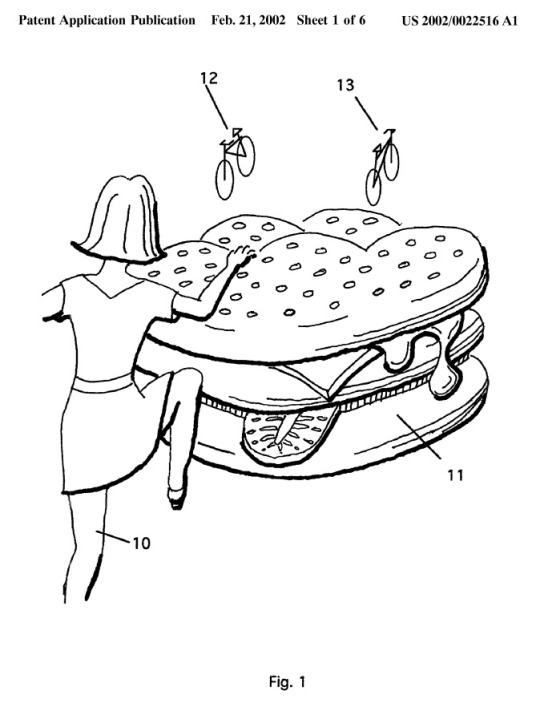
Almost every post on this blog has a header detailing the date of the patent or application and the number, which you can find on the top right. In this case, this image is from Patent Application # 20020022516.
Longtime Context-Free Patent Art fans might remember this image from when it was first featured here over a decade ago. I figured that a lot of the people following the blog now haven't seen some of the gems from years ago, so I'm going to be doing re-runs of some of my favorites this week. There's a bunch more I think would be good to bring back, so I'll use the vintage cfpa hashtag in the future so you know when a duplicate post is intentional (as opposed to me just forgetting I've posted a thing before, which happens a fair bit).
Back to the matter at hand though, if you're ever curious, the US Patent and Trademark Office has a super-handy patent search function. It's pretty easy to find from their main site (uspto.gov), but you can also just bookmark this link to the basic search form:
Check out the search results, click on the link for the .pdf, and you'll get the complete patent/application to peruse at your enjoyment.
In this case, you'll find the patent being applied for covers a method of "Advertising inside electronic games" and you'll learn that:
In FIG. 1, girl 10 is climbing onto a hamburger 11 like one sold at a fast food restaurant. However, in the displayed image, hamburger 11 is as large as girl 10. The person playing the game will therefore perceive hamburger 11 as fantastically large. That unusual scale will help to burnish the image of hamburger 11 in the player's memory as well as draw his attention to it while he plays the game.
Not shown in FIG. 1 are other characteristics which electronic games could apply to hamburger 11 which cannot be shown in unanimated line-drawings. Hamburger 11 will compress as girl 10 steps or pushes on it. That action will be accompanied by squishing and slurping sounds...
Yeah, the explanations are weird too, sometimes.
Sorry for all the words, I just wanted to make it as clear as possible to people that if they're ever curious about stuff they see on Context-Free Patent Art, it's usually pretty easy to find out what the deal is.
139 notes
·
View notes
Text
Watcher's Expenses
I didn't major in accounting: I took three classes and it grinded my brain to a fine powder. However, after graduating with a business admin degree, being a former eager fan of their videos, and from a cursory glance over their socials, there's a lot to consider in their spending behavior that really could start racking up costs. Some of these things we've already noticed, but there are other things I'd like to highlight, and I'll try to break it down into the different categories of accounting expenses (if I get something wrong, let me know. I was more concentrated in marketing 🤷♀️). I'm not going to hypothesize numbers either, as that would take out more time than I'm willing to afford-- you can assume how much everything costs. Anyways, here's my attempt at being a layman forensic accountant:
Note: All of this is assuming they're operating above board and not engaging in any illegal practices such as money laundering, tax evasion, not paying rent, etc.
Operating Expenses
Payroll: 25+ staff salaries and insurance
Overhead Expenses
CEO/founder salaries
Office space leasing or rent (In L.A, one of the most expensive cities in the US)
Utilities (water, electricity, heating, sanitation, etc.)
Insurance
Advertising Costs
Telephone & Internet service
Cloud Storage or mainframe
Office equipment (furniture, computers, printers, etc.)
Office supplies (paper, pens, printer ink, etc.)
Marketing costs (Social media marketing on Instagram, Youtube, SEO for search engines, Twitter, etc. Designing merchandise and posters, art, etc. )
Human Resources (not sure how equipped they are)
Accounting fees
Property taxes
Legal fees
Licensing fees
Website maintenance (For Watchertv.com, Watcherstuff.com, & Watcherentertainment.com)
Expenses regarding merchandising (whoever they contract or outsource for that)
Inventory costs
Potentially maintenance of company vehicles
Subsequent gas mileage for road trips
Depreciation (pertains to tangible assets like buildings and equipment)
Amortization (intangible assets such as patents and trademarks)
Overhead Travel and Entertainment Costs (I think one of the biggest culprits, evident in their videos and posts)
The travel expenses (flights, train trips, rental cars, etc. For main team and scouts)
Hotel expenses for 7-8 people at least, or potentially more
Breakfasts, lunches and dinners with the crew (whether that's fully on their dime or not, I don't know; Ryan stated they like to cover that for the most part)
Recreational activities (vacation destinations, amusement parks, sporting activities etc.)
The location fees
Extraneous Overhead costs (not sure exactly where these fall under, but another culprit, evident in videos and posts)
Paying for guest appearances
Expensive filming & recording equipment (Cameras, sound equipment, editing software subscriptions, etc.)
The overelaborate sets for Ghost files, Mystery Files, Puppet History, Podcasts etc. (Set dressing: Vintage memorabilia, antiquated tech, vintage furniture, props, etc.)
Kitchen & Cooking supplies/equipment
Office food supply; expensive food and drink purchases for videos
Novelty items or miscellaneous purchases (ex. Ghost hunting equipment, outfits, toys, etc.)
Non-Operating Expenses
These are those expenses that cannot be linked back to operating revenue. One of the most common examples of non-operating expenses is interest expense. This is because while interest is the cost of borrowing money from a creditor or a bank, they are not generating any operating income. This makes interest payments a part of non-operating expenses.
Financial Expenses
Potential loan payments, borrowing from creditors or lenders, bank loans, etc.
Variable Expenses
Hiring a large amount of freelancers, overtime expenditure, commissions, etc.
PR consultations (Not sure if they had this before the scandal)
Extraordinary Expenses
Expenses incurred outside your company’s regular business activities and during a large one-time event or transactions. For example, selling land, disposal of a significant asset, laying off of your employees, unexpected machine repairing or replacement, etc.
Accrued Expenses
When your business has incurred an expense but not yet paid for it.
------------------------------------------------------------------------------------------------------------------------
(If there's anything else I'm missing, please feel free to add or correct things)
To a novice or a young entrepreneur, this can be very intimidating if you don't have the education or the support to manage it properly. I know it intimidates the hell out of me and I'm still having to fill in the gaps (again, if I've mislabeled or gotten anything wrong here, please let me know). For the artistic or creative entrepreneur, it can be even harder to reconcile the extent of your creative passions with your ability to operate and scale your business at a sustainable rate. That can lead to irresponsible, selfish, and impulsive decisions that could irreparably harm your brand, which is a whole other beast of its own.
My guess at this point is that their overhead and operation expenses are woefully mismanaged; they've made way too many extraneous purchases, and that they had too much confidence in their audience of formerly 2.93 million to make up for the expenses they failed to cover.
It almost seems as if their internal logic was, "If we make more money, we can keep living the expensive lifestyle that we want and make whatever we want without anyone telling us we can't, and we want to do it NOW, sooner rather than later because we don't want wait and compromise our vision." But as you can see, the reality of fulfilling those ambitions is already compromised by the responsibility of running a business.
And I wrote this in another post here, but I'll state it again: Running a business means you need to be educated on how a business can successfully and efficiently operate. Accounting, marketing, social media marketing, public relations, production, etc; these resources and internet of things is available and at your disposal. If they had invested more time in educating themselves on those aspects and not made this decision based on artistic passion (and/or greed), they would have not gotten the response they got.
Being a graphic designer, I know the creative/passionate side of things but I also got a degree/got educated in business because I wanted to understand how to start a company and run it successfully. If they’re having trouble handling the responsibility of doing that, managing production costs, managing overhead expenses, and especially with compensating their 25+ employees, then they should hire professionals that are sympathetic to their creative interests, but have the education and experience to reign in bad decisions like these.
Anyways, thanks for coming to my TedTalk. What a shitshow this has been.
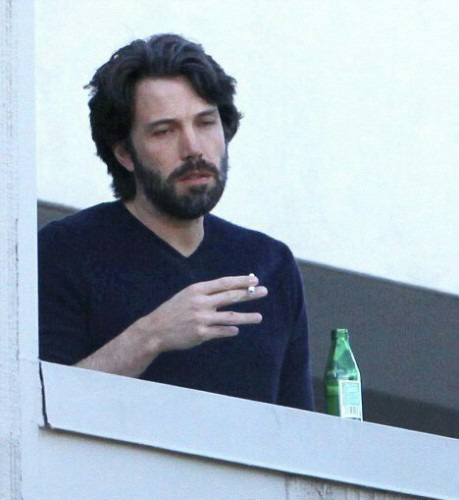
#watcher#watcher entertainment#ryan bergara#shane madej#steven lim#watcher tv#watchergate#accounting
63 notes
·
View notes
Note
copyright hurts me as an indigenous person because dead white people own the likenesses of my ancestors faces in photos. they own the little history of ours that is written down in old books and newspapers, i cannot access for copyright reasons. they came and captured our faces for "science", for their own personal interest and now we are owned after death
I'm sorry.
I don't know much about this this issue, but here are a few links for people who might like to know more (leaning heavily on legal sources and focusing mostly on the U.S. - other people please feel free to add more links and information).
One recent example of white people copyrighting and selling language back to Lakota peoples that received a fair amount of news coverage:
A 1996 paper about Native American's potential right (and lack of rights) to request or demand the return of photographs held by museums:
An ABA article from this year that discusses in broad terms the lack of protection for Native American culture and traditional knowledge in the U.S.'s current intellectual property system, and the need for such protection:
An article about the 2018 Music Modernization Act could affect recordings of Native American songs, stories, and languages, that includes a broader critique of the fundamental assumptions of U.S. copyright law:
A similar discussion out of Canada:
Which links to another horrifying story of theft stories, history, and language, and details how the law made such a theft possible:
And a recent law review article proposing a path to increase protection for Indigenous works under current law, which isn't quite on point but contains some interesting discussion of the legal landscape and potential practical suggestions (although I am skeptical as to how likely or effective they could be):
29 notes
·
View notes
Text
Meghan Markle receives huge blow as major American Riviera Orchard request is rejected by u/AurelieR1
Meghan Markle receives huge blow as major American Riviera Orchard request is rejected
https://ift.tt/XHAYmhu Express:Meghan Markle's new lifestyle brand, American Riviera Orchard, has suffered a setback after her US trademark application was rejected.The Duchess of Sussex has now been given three months to respond to the "nonfinal officer action" issued by the United States Patent and Trademark Office (USPTO).She has been warned that failure to do so could result in her application being abandoned.In their consideration of her trademark bid, Meghan was also told she needed to cough up another $700 (£532) if she wanted to proceed after failing to pay the correct fee initially.In their 48-page action, USPTO officials explained why Meghan's trademark bid failed to be successful.[Article continues.]
post link: https://ift.tt/uo4l1ki
author: AurelieR1
submitted: September 03, 2024 at 02:02PM via SaintMeghanMarkle on Reddit
disclaimer: all views + opinions expressed by the author of this post, as well as any comments and reblogs, are solely the author's own; they do not necessarily reflect the views of the administrator of this Tumblr blog. For entertainment only.
#SaintMeghanMarkle#harry and meghan#meghan markle#prince harry#fucking grifters#grifters gonna grift#Worldwide Privacy Tour#Instagram loving bitch wife#duchess of delinquency#walmart wallis#markled#archewell#archewell foundation#megxit#duke and duchess of sussex#duke of sussex#duchess of sussex#doria ragland#rent a royal#sentebale#clevr blends#lemonada media#archetypes with meghan#invictus#invictus games#Sussex#WAAAGH#american riviera orchard#AurelieR1
31 notes
·
View notes
Note
immediately correct us trademark office in your bio to us patent and trademark office in your bio. or Else
I have no issue with the patents, my issue is purely with the trademarks
40 notes
·
View notes
Text
From the second the message popped up on X, it had a familiar ring. Jools Lebron, the TikTok creator who went viral just a few weeks ago for a post discussing “very demure, very mindful” work looks, was upset that, seemingly, someone had attempted to trademark her viral phrase.
In a since-deleted video, Lebron lamented through tears that her future ability to sell demure-branded merchandise seemed in jeopardy. “I wanted this to do so much for my family, provide for my transition, and I just feel like I dropped the ball,” Lebron said, adding that “someone else has it now, and I don’t even know what I could have done better, because I didn’t have the resources.”
Lebron’s situation is echoed in the story of fellow Chicagoan Peaches Monroee. Back in the summer of 2014, the then-teenager posted a video on TikTok precursor Vine describing her eyebrows as “on fleek.” Her catchphrase caught on everywhere, from Nicki Minaj lyrics to Kim Kardashian posts. #Brands like Taco Bell hopped on the trend; Forever 21 made crop tops. Monroee, aka Kayla Lewis, reaped no rewards. Three years after the trend went viral, she launched a GoFundMe and raised just shy of $17,000, according to the campaign’s page.
Like “on fleek,” “demure” has attracted scores of admirers. Jennifer Lopez. The White House. Kim Kardashian (again). Earthquake survivors. The original video has nearly 50 million views, and Lebron’s follower count is now above 2 million. She appeared on Jimmy Kimmel Live! while RuPaul was serving as guest host. But her ability to seize her moment of internet fame may not meet exactly the same fate as Lewis’. Despite the fact that a Washington resident named Jefferson A. Bates and the company Do or Drink both filed “demure” applications with the US Patent and Trademark office, Lebron posted a TikTok on Tuesday saying that it’s been “handled.” “Mama got a team now!” she exclaimed, smiling.
Exactly how it got handled is unclear—Bates didn’t respond to an email seeking comment, and representatives for Lebron and Do or Drink didn’t reply, either. Still, the tug-of-war marks something of a shift in how the internet understands the value of trends. Almost as soon as word of the “demure” trademarks surfaced, social media sprung into action decrying the fact that anyone other than Lebron would try to claim the phrase.
One lawyer on TikTok, who uses the handle @bellewoods, did a breakdown explaining that “Jools is going to be just fine” because of the intricacies of how the trademark system in the US works. Another TikTokker claimed to have filed her own trademark application with the intention of transferring ownership to Lebron. (Though, as a Washington Post story this week pointed out, transferring a trademark may not be so easy.) In the comments section of the “handled” TikTok, brands ranging from Ritz Crackers to Zillow weighed in with emoji-strewn affirmations.
All of this underscores that, unlike 10 or 15 years ago, there is now a greater understanding that “content creation is labor,” says Kate Miltner, a lecturer in data, AI, and society at the University of Sheffield’s Information School. “It is time-consuming and often poorly remunerated labor for the most part,” but far more people make entire careers out of being content creators than a decade ago, Miltner adds, “and it feels like an ethics of plagiarism, in addition to trademark/copyright, have come into play.”
Simply put, people get this shit now. A decade after “on fleek,” creators are much smarter when it comes to ownership of their creations. “A series of conversations and discourses about cultural appropriation and where a lot of contemporary (online) language comes from (Black communities, queer communities) have happened since Peaches Monroee,” Miltner says. Lebron may have felt like she dropped the ball because of a lack of resources, but the resources she did have were other creators who knew how to call out what had happened. She also had companies like Netflix, which—perhaps anticipating blowback for just hopping on a viral trend—just asked that Lebron curate a “Very Demure, Very Mindful” list.
Will this happen every time? No. Memes built from everyday language will always be hard to trademark—Miltner cites Fox Media’s unsuccessful attempt to trademark “OK Boomer” as an example. But now that even Hawk Tuah Girl has merch, the possibilities of getting credit for your meme, or even cash, don’t seem as unlikely as they did before. Might your meme get ingested and reinterpreted by an artificial intelligence bot? Yes. Will that bot be able to make a T-shirt? Er, well, that might happen, too. Creators, especially minority creators, will always have to fight to keep control of their works once they’ve been unleashed onto the world. Now, though, they have a few more coaches in their corner.
17 notes
·
View notes
Text
A little tidbit related to the recent Glitch Inn promo:
Back in January 2024, Glitch Productions filed for a trademark on the word "AniMiniz." (I'm using Australia's national trademark database because it's where they're based, but it can also be seen by using the United States Patent and Trademark Office's trademark search.) Each mark must be filed under one or more "classes," categorizing them in accordance with what they're meant to be used for.

As you can see, the only class for this trademark is specifically for figures, plushies, and whatnot. I happened across this back around April or so - based on both this and the name's similarity to "AniMatez" (their existing line of figurines), I naturally assumed it indicated that they planned on introducing a new line in the future.
Cut to a few days ago. Glitch makes an announcement:

The designs used in promotional material are dubbed "AniMiniz," marking what I'm pretty sure is the first official use of the term. The very end of the video (~4:00) teases the possibility of further animations starring these versions of the cast, too.
Now, I'm not too confident in my ability to properly prognosticate, but I think it's a safe bet that they still have plans to merchandise these designs in some fashion. They certainly look quite marketable, on top of the evidence presented previously.
Put another way:

17 notes
·
View notes
Text
Alright, someone needs to issue a definitive ruling on what The Naco actually is. Ron Stoppable's invention debuts in "Bueno Nacho" and eventually makes him a millionaire. He describes it as "taco meets nacho" and he clearly invents it by wrapping an order of nachos in a giant tortilla.

Bueno Nacho adds it to the menu at some point and the recipe is modified a bit (lettuce and tomato were not part of the original creation). The real question is how to approximate the food that was clearly not meant for actual human consumption in real life.
Fun fact, while recipes would make sense as a "useful article" and therefore should be protected by patent law, they aren't considered novel and have to be protected by copyright or trade secret law. That actually benefits Ron, who I am sure never registered with the Patent and Trademark Office.
Babish had to try it twice (first here and then here). He had to redo it because he didn't include bright yellow queso or ground beef . . . and I think that's right. Both are things integral to the platonic ideal of a Naco.
Will Friedle and Christy Carlson Romano made Nacos together too. I think they basically get pretty close. Theirs are shaped like tacos and not dripping, but close.
I think if you're actually trying to capture what eating a Naco is about (based on the show), there are a few notes you have to hit:
It needs to crunch when you eat it.
It needs to be basically dripping with grease and cheese.
It somewhat needs to be shaped like a bindle.
All that said, I do think there is a Naco approximation readily available for anyone -- and that's the Crunchwrap at Taco Bell. Though not shaped like a bowl, it's basically taco filling in a tortilla with a tostada for the crunch.
Additional Fun Fact: Taco Bell used to have menu items that people approximated even closer to the Naco that were discontinued.
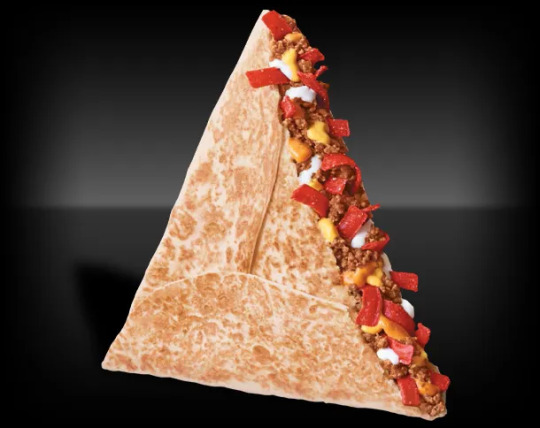

The thing Ron makes just isn't wieldy enough, tasty enough, or worth it to attempt to try and make an approximation of it in real life. So make a Crunchwrap instead, use Joshua Weissman's recipe (don't waste any of your life eating at an actual Taco Bell), and replace the tostada with tortilla chips, because who has the time?
22 notes
·
View notes
Text
Preface: I have no idea about the details of copyright/trademark rules.
So, who the heck does the copyright for superhero merch in the DC universe?
There's tons of hero merch everywhere. Shirts, PJs, Bat Burger. But who's got the rights for the superhero's logo? Superman can't exactly go to a patent office and sign his patent on the big S shield with what is legally just a nickname. So is everybody using superhero logos under a sort of public domain? I'd find that extremely hard to believe; if the heroes didn't claim their logos, then someone would.
I think it makes sense for Bruce Wayne to patent and trademark all of the hero's logos and appearances. People already know Bruce Wayne funds Batman, so he has ties to the superhero community. Plus, he's the kind of guy to take money from merch sales and put it straight into a charity or relief fund, which is exactly what all of the other heroes would want, anyway.
It also makes for a funny/intimidating scenario in which Batman is basically holding the door to being a hero. Imagine being new to the Justice League and running into him completely on accident and he starts interrogating you as to why you never submitted your logo or costume design, you never gave notice of your status as a hero through the proper channels, you've already been on camera seven times and it's frankly a miracle the rights to your suit design haven't been taken right out from under you. You could've been sued out of your costume for copyright infringement by now.
Honestly, this is something I think about a lot.
147 notes
·
View notes
Text


Biotechnology and the future of humanity
Animals Are Commodities Too
Under slavery human individuals are owned, are property. Under capitalism workers aren’t owned but they have to sell their labour/time/creativity because capitalists own everything (land, the means of production, transport and communication etc) that would enable people to live outside of wage labour and the market place. Now, instead of individuals owning non-human animals as part of their subsistence, corporations are claiming the right to ‘own’ whole species of animals. This process of patenting life can be traced back to the 1980 US Supreme Court ruling, which stated that a GM bacterium (modified to digest oil) could be patented. Not just that one bacterium of course but the whole, created species. In 1985 the US Patent and Trademark Office ruled that GM plants, seeds and plant tissues could be patented. Now the corporations can demand royalties and licence payments every time farmers use those plants or seeds. Monsanto holds a patent on (i.e. owns and rents out) all GM cotton and soya. Patents have been granted on biological characteristics of plants as well. For example, a patent has been issued to Sungene for a variety of sunflower that has a high oleic acid content. But the patent covers the characteristic as well as the genes that code for it, so any plant breeder who achieves the same result by traditional methods could be sued.
In 1987 animals joined the biotech market place when a Harvard biologist patented ‘oncomouse’, a GM organism (mouse) predisposed to develop cancer for use in medical ‘research’. By 1997 40 GM ‘species’ of animal had been patented, including turkey, nematodes, mice and rabbits. Hundreds of other patents are pending on pigs, cows, fish, sheep and monkeys among others. In 1976 a leukaemia patient named John Moore had his cancerous spleen removed under surgery at the University of California. Without his knowledge or consent some of the cells from his spleen were cultured and found to produce a protein which could be used in the manufacture of anti-cancer drugs. The estimated value of this cell-line to the pharmaceutical industry is $3 billion. In 1984 the California Supreme Court ruled that he was not entitled to any of these profits.
A US company called Biocyte holds a patent on (owns) all umbilical cord cells. Systemix Inc has a patent on (owns) all human bone marrow stem cells, these being the progenitors of all cells in the blood. The worldwide market for cell lines and tissue cultures was estimated to be worth $426.7 million to the corporations in 1996. Not only cells but also fragments of DNA can be patented (owned) in this way. Incyte, for example, has applied for patents on 1.2 million fragments of human DNA. The logic of this is that ‘genes for’ particular diseases such as cystic fibrosis, diabetes, various cancers etc could become the property of pharmaceutical companies who could then make huge profits on tests for such genes and genebased therapies. There is no space here to get into a lengthy criticism of the reductionist idea that individual genes simply map onto well-defined physical traits underlying the whole theory and practice of GM. It’s enough to say that research into patenting (owning), for example, a supposed’ breast cancer gene’ is of little benefit to humanity if it is true, as some scientists have estimated, that 90% of breast cancers are unrelated to genetics but are triggered by environmental pollution, diet and lifestyle factors. So what’s new? Capitalism, indeed class-society in general, always seizes the living and turns it into profit and power, declares ownership where previously there was only life: from the enclosure of the commons to the seizing of millions of human beings from Africa to be slaves to the current looting of tropical biodiversity for use in the biotech labs.
#classism#ecology#climate crisis#anarchism#resistance#community building#practical anarchy#practical anarchism#anarchist society#practical#revolution#daily posts#communism#anti capitalist#anti capitalism#late stage capitalism#organization#grassroots#grass roots#anarchists#libraries#leftism#social issues#economy#economics#climate change#climate#anarchy works#environmentalism#environment
5 notes
·
View notes